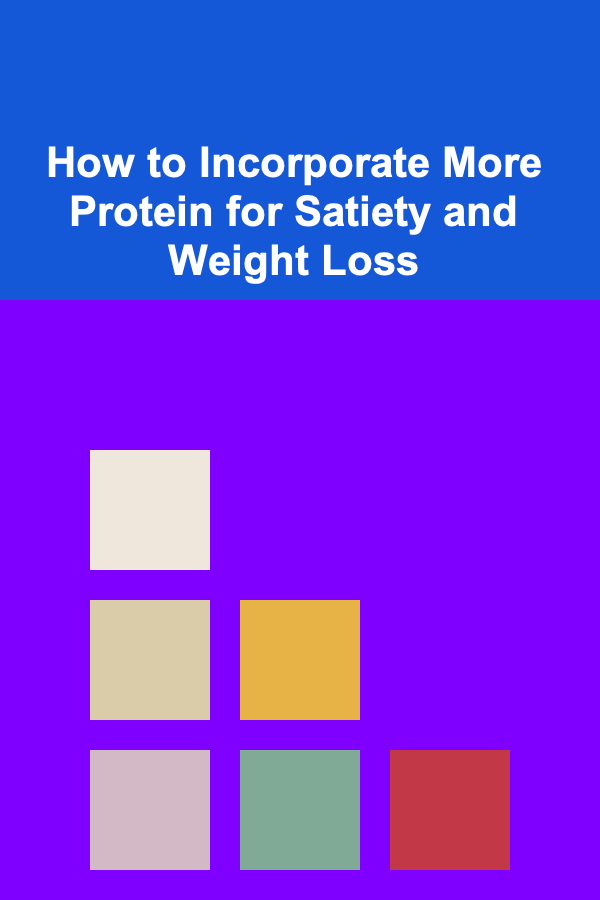
How to Incorporate More Protein for Satiety and Weight Loss
ebook include PDF & Audio bundle (Micro Guide)
$12.99$5.99
Limited Time Offer! Order within the next:

Protein is one of the most crucial macronutrients in our diet. It serves various roles in the body, from repairing tissues to supporting immune function and making enzymes and hormones. However, beyond its functional importance, protein plays a significant role in weight management. When it comes to satiety (the feeling of fullness) and weight loss, protein can be a game-changer. This article will explore how you can incorporate more protein into your diet, why protein helps with satiety, and how it can contribute to effective weight loss.
The Science of Protein and Satiety
Before we dive into the specifics of how to incorporate more protein into your meals, it's important to understand how protein helps with satiety and weight loss.
1. Protein and Appetite Regulation
One of the primary reasons why protein is so beneficial for weight loss is its ability to reduce hunger and increase feelings of fullness. Studies have shown that protein increases the release of hormones that promote satiety, such as GLP-1 (glucagon-like peptide-1), peptide YY, and cholecystokinin, while simultaneously lowering the levels of ghrelin, the hormone that stimulates appetite.
This hormonal response means that when you eat a meal rich in protein, you tend to feel fuller for longer, which can reduce the overall calorie intake throughout the day. This is one of the reasons why high-protein diets are often recommended for those looking to lose weight.
2. Thermic Effect of Food (TEF)
The thermic effect of food refers to the energy required to digest, absorb, and metabolize food. Protein has a higher thermic effect compared to fats and carbohydrates. Approximately 20-30% of the calories in protein are burned through digestion, while only 5-15% of calories in fats and carbohydrates are burned in this process.
This means that consuming protein-rich foods requires more energy from your body, helping you burn more calories throughout the day, which is beneficial for weight loss.
3. Muscle Preservation During Weight Loss
Another crucial role of protein in weight loss is its ability to preserve muscle mass. When you're in a caloric deficit (the condition needed for weight loss), your body not only burns fat but also breaks down muscle tissue for energy. A higher intake of protein helps to prevent the loss of muscle mass, ensuring that the weight you lose is primarily from fat rather than lean tissue. Maintaining muscle mass is important because muscle tissue burns more calories at rest than fat tissue, which can help with long-term weight management.
How Much Protein Do You Need?
The amount of protein you need can vary depending on factors such as age, gender, activity level, and weight loss goals. However, there are general guidelines that can help you determine how much protein to incorporate into your daily diet.
1. General Recommendations
For the average adult, the recommended daily intake of protein is around 0.8 grams per kilogram of body weight. However, if you're aiming to lose weight or build muscle, this amount may need to be higher.
- For weight loss, aim for at least 1.2 to 1.6 grams of protein per kilogram of body weight.
- For muscle gain, aim for 1.6 to 2.2 grams per kilogram of body weight, depending on the intensity of your workouts.
For example, a 70-kilogram individual (154 pounds) who is aiming for weight loss should aim to consume between 84 to 112 grams of protein per day.
2. Protein Distribution Across Meals
To maximize the benefits of protein for satiety and weight loss, it's essential to spread your protein intake evenly across meals throughout the day. Consuming protein in every meal helps maintain steady blood sugar levels and promotes feelings of fullness consistently. Aim for 20-30 grams of protein per meal, which is generally considered the optimal amount for satiety and muscle preservation.
Protein-Rich Foods to Include in Your Diet
Now that we understand the science behind protein and its role in satiety and weight loss, let's discuss some protein-rich foods that you can incorporate into your daily meals. These foods will help you meet your protein needs while also contributing to a healthy, balanced diet.
1. Animal-Based Protein Sources
Animal-based proteins are typically complete proteins, meaning they contain all nine essential amino acids that the body cannot produce on its own. They are highly bioavailable, which means they are efficiently absorbed by the body.
a. Chicken and Turkey Breast
Lean poultry like chicken and turkey breast is one of the best sources of protein. A 3-ounce serving of skinless, cooked chicken breast provides around 26 grams of protein with minimal fat content, making it a great choice for anyone looking to lose weight while maintaining muscle.
b. Fish and Seafood
Fish such as salmon, tuna, and cod, as well as other types of seafood, are excellent sources of protein and healthy fats. Salmon, for instance, provides around 22 grams of protein per 3-ounce serving and is rich in omega-3 fatty acids, which have been linked to reduced inflammation and improved heart health.
c. Eggs
Eggs are one of the most affordable and versatile protein sources. One large egg contains about 6 grams of high-quality protein. In addition to protein, eggs also provide essential vitamins and minerals, including vitamin D, choline, and B vitamins.
d. Greek Yogurt
Greek yogurt is another great source of protein. A 6-ounce serving of plain Greek yogurt contains about 15-20 grams of protein, depending on the brand. Opt for plain, unsweetened Greek yogurt to avoid added sugars that could hinder your weight loss goals.
2. Plant-Based Protein Sources
For those who follow a vegetarian or vegan diet, plant-based protein sources are an excellent alternative. While many plant-based proteins are not complete (they may lack one or more essential amino acids), they can still be incorporated into a balanced diet to provide sufficient protein when combined properly.
a. Legumes and Beans
Beans, lentils, and chickpeas are high in protein and fiber, both of which help with satiety. A 1-cup serving of cooked lentils provides around 18 grams of protein, while a cup of chickpeas offers about 15 grams of protein. These legumes are also rich in iron, folate, and other micronutrients.
b. Tofu and Tempeh
Both tofu and tempeh are made from soybeans and are excellent plant-based protein sources. Tofu contains about 10 grams of protein per 4-ounce serving, while tempeh, which is fermented, provides around 21 grams of protein per 4-ounce serving. Both are versatile and can be used in a variety of dishes, from stir-fries to smoothies.
c. Quinoa
Quinoa is a complete plant-based protein, providing all nine essential amino acids. A 1-cup serving of cooked quinoa provides about 8 grams of protein, making it an excellent addition to salads, grain bowls, or as a side dish.
d. Nuts and Seeds
Nuts and seeds, such as almonds, peanuts, chia seeds, and hemp seeds, are great sources of protein and healthy fats. While they can be calorie-dense, they offer a good amount of protein per serving. For example, a 1-ounce serving of almonds provides about 6 grams of protein.
3. Protein Supplements
If you're struggling to meet your protein needs through whole foods alone, protein supplements can be a convenient way to increase your intake. Whey protein, casein, and plant-based protein powders (e.g., pea or hemp protein) are popular options. While it's always best to prioritize whole foods, protein supplements can be a helpful addition when you're on the go or looking to boost your protein intake without increasing calorie consumption.
Meal Ideas for Protein-Rich Diets
Incorporating more protein into your diet doesn't have to be complicated. Here are some meal ideas to help you get started:
1. Breakfast
- Scrambled eggs with spinach and feta cheese: A protein-packed breakfast that provides healthy fats and fiber.
- Greek yogurt with chia seeds and berries: High in protein and antioxidants, perfect for a filling start to the day.
- Protein smoothie with whey protein, almond milk, spinach, and a banana: A quick and easy option for on-the-go nutrition.
2. Lunch
- Grilled chicken salad with mixed greens, avocado, and a balsamic vinaigrette: A lean protein paired with healthy fats and fiber.
- Quinoa and chickpea bowl with roasted vegetables: A plant-based, high-protein meal that's both satisfying and nutrient-dense.
- Tuna salad with mixed greens and olive oil dressing: A low-calorie, high-protein option that keeps you full for hours.
3. Dinner
- Salmon with roasted sweet potatoes and steamed broccoli: A nutritious and satisfying dinner that's rich in protein and omega-3s.
- Tofu stir-fry with vegetables and brown rice: A plant-based protein-packed dinner full of fiber and antioxidants.
- Lean beef or turkey chili: A hearty, protein-rich meal that also includes fiber from beans and vegetables.
4. Snacks
- Hard-boiled eggs: Simple and portable protein snacks.
- Protein bars or protein shakes: Convenient options when you need an on-the-go snack.
- Hummus with raw veggies: A protein-rich dip with plenty of fiber.
Conclusion
Protein is an essential macronutrient that can significantly contribute to satiety, weight loss, and overall health. By incorporating more protein-rich foods into your diet, such as lean meats, fish, eggs, beans, tofu, and protein supplements, you can reduce hunger, improve muscle preservation, and support your weight loss efforts. Remember to aim for a balanced approach by spreading your protein intake throughout the day and focusing on whole, minimally processed foods to get the most benefit.
By making small, sustainable changes and being mindful of your protein intake, you can unlock the power of this macronutrient and move closer to achieving your weight loss and health goals.

How to Research Your New Neighborhood Before Moving
Read More
How to Throw a Surprise Party at Home Without Giving It Away
Read More
How to Use a Calendar to Plan Your Travel Dates Effectively
Read More
How To Cook Delicious Meals While Camping
Read More
How to Plan Your Public Speaking Practice Sessions
Read More
How to Conduct a Workday Audit Checklist
Read MoreOther Products

How to Research Your New Neighborhood Before Moving
Read More
How to Throw a Surprise Party at Home Without Giving It Away
Read More
How to Use a Calendar to Plan Your Travel Dates Effectively
Read More
How To Cook Delicious Meals While Camping
Read More
How to Plan Your Public Speaking Practice Sessions
Read More